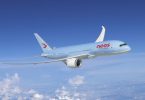What does the future hold for Uganda airlines? Once the dust has settled over the current election campaign, we probably need a sober analysis as to what Uganda needs in terms of connectivity, and a sit-down with the two regional airlines which are part of the NCIP platform before drawing in the international carriers for similar talks.
Since the exit of Air Uganda, which fell victim to the shenanigans of the Uganda Civil Aviation Authority (UCAA) a year-and-a-half ago, the Ugandan flag has not been flown across the region, unless of course by the smaller airlines which predominantly serve the domestic market and the nearer region with either single-engine or twin-engine turboprop aircraft.
For a period of time, there was a hype to restart Uganda Airlines, a national airline which was closed when no strategic investors could be found and after it had been stripped of both the money-making ground-handling and eventually the equally money-making franchise in one of the global CRS, aka computerized reservation systems used by travel agents to book flights and a range of additional travel services.
Setting up an airline, even of the relatively small size like Air Uganda, today runs into the tens of millions of US dollars, unless one settles for aged aircraft which then often turn out to be notoriously unreliably with technical problems, leave alone being fuel guzzlers. If then the owners decide to go long haul, and need state-of-the-art wide-body aircraft, the cost to acquire those can run into the hundreds of millions of US dollars for new planes, and even for pre-owned aircraft the cost is often mindboggling.
Also to be considered before setting up a new national airline is of course the potential passenger base, and with Uganda being well served by the leading Gulf carriers – Emirates, Qatar Airways, Etihad Airways, and FlyDubai are all flying either daily or multiple times each week to Entebbe – it is an open question if such a startup airline can stand the competitive heat and survive those crucial early years, even given that a government has the money to subsidize such an operation – which we in Uganda presently do not have in the absence of oil revenues – and to burn several hundred millions of dollars.
Competition closer to home, like Ethiopian Airlines, also has to be factored in, and as their network literally serves the world now, and not just one or two international destinations, plus the ability to earn frequent flyer miles with them and their Star Alliance partners, the prospect of establishing a new national airline becomes even more daunting.
In Africa, apart from perhaps some smaller players, all the big league airlines have made massive losses in the recent past, except Ethiopian Airlines which posted a profit of over 170 million US dollars last year. Egypt Air is deep in the red, as is South African Airways at the opposite end of the continent, and in our part of the world, Kenya Airways last year posted a major loss, too. Combine those figures and one can easily come up with well over 800 million US dollars in losses last year alone, money many countries would rather spend on social services, health, education, clean water, and other more pressing areas than sinking it into an airline.
When Air Uganda was compelled to close down, connectivity of course suffered severely, and it took the Ugandan regulators months on end before they finally woke up and granted RwandAir and Ethiopian traffic rights out of Entebbe to serve the Juba route. For RwandAir, now literally the adopted home airline for Ugandans, soon the next bonus came about when Uganda granted them fifth freedom rights between Entebbe and Nairobi. After a difficult start, with the Kenyan regulators creating obstacle after obstacle – only a Head of State intervention in December last year eventually had them yield – RwandAir is now flying twice a day between Entebbe and Nairobi. This is the bread and butter route for Kenya Airways in the region, and with five flights a day, they do ensure connectivity, for point to point passengers and those flying via Nairobi into the region, across Africa, and beyond. Two other airlines from Kenya also fly on the route – FlySax and African – the latter via Nairobi to Mogadishu, also a route initially lost to Ugandans when Air Uganda ceased to operate. Both of those, however, use aged equipment and both feel the competitive heat by the predominant airlines using newer planes, offering superior onboard services and in addition offering excellent frequent flyer programs.
More recently, the Heads of State of the NCIP countries, short for Northern Corridor Integration Project countries – Kenya, Uganda, Rwanda, and South Sudan – have taken another step towards ensuring both better connectivity and more affordably fares, when they directed their aviation bureaucrats to integrate the airspaces, lift non-tariff barriers, and allow the two predominant airlines in East Africa – Kenya Airways and RwandAir – to serve NCIP countries without a national airline to a better extend.
RwandAir, already operating a fleet of six jets and two turboprop aircraft, all but two acquired new from the manufacturers, have in view of that development ordered another two Boeing B737-800NGs for delivery in 2016 to increase destinations and frequencies on high-demand routes. This will be followed by two Airbus A330 wide-body long-haul aircraft, which will join the RwandAir fleet in September and December this year respectively. At that stage, RwandAir will then offer long-haul services to China, India, and Europe, with final destinations still to be confirmed.
By doing so, the Rwandan national airline, 100 percent owned by the Rwandan state, has served notice that they are ready to give Ugandans the connections they are seeking. Besides the presently two daily Nairobi services and the daily flight to Juba, indications are there that Nairobi will sooner or later get a third flight while other regional destinations are served via Kigali, to Kilimanjaro/Arusha, Dar es Salaam, Mombasa-Dubai, Lusaka-Johannesburg, and of course to now five West African destinations – Brazzaville, Libreville, Douala, Lagos, and Accra.
Kenya Airways meanwhile has completed the delivery of their nine state-of-the-art Boeing B787 Dreamliners and can offer Ugandan travelers, via Nairobi, access to their African, European, Middle Eastern, Indian, and Southeast Asian destinations which include Dubai, Mumbai, Bangkok, Hong Kong, Guangzhou, and Ho Chi Minh City, formerly known as Saigon.
Given such prospects, and of course as long as these two airlines offer fares which are competitive vis-a-vis the main Gulf airlines, Turkish and the European legacy carriers like Brussels Airlines and KLM – British Airways, like they did with Dar es Salaam last year have ditched Entebbe from their African network – the question arises, what a new national airline could do better or at lesser cost for the country.
Tourism promoters have repeatedly stated that as long as the present number of airlines flying to Entebbe continue to gradually raise their flight numbers, and the UCAA manages to attract additional airlines to serve Entebbe, such connectivity is all they need to bring more and more tourists into the country.
“The thing with these airlines is that they all promote Entebbe across their network and the routes they fly to. Emirates, Qatar, Etihad, Turkish, Fly Dubai, Brussels Airlines, KLM and of course our own East African brothers at KQ and RwandAir, they all promote Uganda. Even Ethiopian does that. Perhaps they are not very visible in terms of big time advertising or media presence but they still sell inbound and outbound. It is here that we maybe need to be more proactive. We have to join forces with these airlines to promote Uganda, bring travel agents to see our parks, bring travel journalists to write about us and bring TV teams to feature our natural attractions. Some people say you can only rely on a national airline but honestly speaking, I just as well rely on Emirates or Qatar because a Ugandan national airline could never match their network and can never match their inflight services. If travelers do not have such choices, they might in fact not come at all. Also, if we work hand in hand with them, they see that there is a very keen interest from Uganda to promote this route and that makes a big difference for them,” said a senior tourism stakeholder without wishing to be quoted by name.
Uganda should not be shy to name terms and conditions, for granting access to our airspace and for granting fifth freedom rights which permit non-Ugandan airlines to pick up traffic and cargo enroute to a final destination. Aviation regulators should have both tourism and trade stakeholders on the table to get these two hugely important sector’s needs formulated and presented, so when new aviation accords, known as Bilateral Air Services Agreements are signed in the future, Uganda’s interests are well taken care of without the need to spend mega bucks and yet with the assurance that similar benefits can materialize for the country.






















